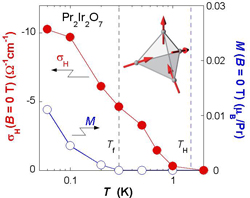Spontaneous Hall Effect as Evidence of Hidden
Time-Reversal Symmetry Breaking in a Frustrated Magnet
Nakatsuji and Sakakibara Groups
The anomalous Hall effect (AHE) is a fundamental transport phenomenon where the electric current generates the transverse voltage drop in the normal plane to the spontaneous magnetization M in ferromagnets. This issue has attracted revived interest because of its topological and dissipationless character, and its potential application in spintronics. In particular, it has been shown that the intrinsic mechanism of the AHE can capture the dominant part in moderately dirty metals. This intrinsic AHE can be understood in terms of the adiabatic motion of the Bloch electrons under the electric field E, which acquire a quantum geometrical phase, the Berry-phase curvature bnk, in the wavevector (k) space because of the relativistic spin-orbit interaction and the spin magnetization. This bnk acts as a fictitious magnetic field in the k space and bends the orbital motion of electrons as in the case of the Lorentz force due to the real magnetic field B. Thus, it causes the AHE characterized by the finite Hall conductivity σH at B = 0.

Fig.1. Temperature dependence of the remnant Hall conduc tivity σH(B=0) (left axis) and remnant magnetization M(B=0) (right axis) at zero field, obtained after a field sweep down from 7 T in the hysteresis loop measurements of the pyrocholore oxide Pr2Ir2O7. Inset: unit of the pyrochlore lattice``2-in, 2-out" configuration of four <111> Ising spins on a tetrahedron.
Notably, the condition for observing the AHE at B = 0 is the macroscopically broken time reversal symmetry (T), which ensures a nonzero average of bnk over the occupied Bloch states. It does not necessarily require a finite ferromagnetic spin alignment, but a noncoplanar spatial distribution of spins. Unconventional scenarios directly relying on a noncoplanar spin texture with the uniform scalar spin chirality have been addressed for ferromagnets. The macroscopically broken time-reversal symmetry and a resultant nonzero σH in the absence of a uniform spin magnetization have also been proposed in antiferromagnetic (AF) states and spin-liquid states with the scalar spin chirality. In this exotic example of a chiral spin-liquid, the uniform scalar spin chirality shows the long-range order (LRO, but the spin magnetic moment does not. However, the AHE at zero field has never been observed to date in the absence of the uniform spin magnetization associated with the ferromagnetism or the spin freezing.
We have recently discovered the macroscopically T broken spin-liquid state in a metallic magnet [1]. In particular, we observe the spontaneous Hall effect in the geometrically frustrated Kondo lattice Pr2Ir2O7 even above its spin freezing temperature Tf ∼ 0.3 K. A clear hysteresis is observed in the Hall conductivity around zero field below the onset temperature TH ∼ 1.5 K, whereas that in the magnetization curve appears only below Tf within an experimental accuracy. Namely, a large anomalous Hall conductivity σHis found even at zero field where the magnetization practically vanishes (Fig. 1), in sharp contrast to the conventional AHE in ferromagnets. This indicates an emergence of a hidden order at TH that macroscopically breaks the time reversal symmetry without invoking a LRO of dipolar spins. The phenomenon may be understood in terms of a formation of the uniform spin chirality out of “2-in, 2-out” configurations (inset of Fig. 1) of localized magnetic moments of Pr3+ ions in an analogy to spin-ice systems.
References
- Y. Machida, S. Nakatsuji, S. Onoda, T. Tayama, T. Sakakibara, Nature, 463, 210 (2010).
